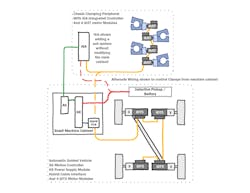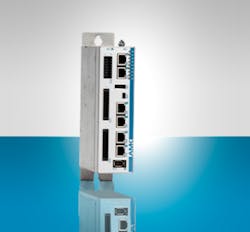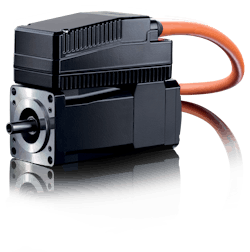Automatic guided vehicles (AGVs) are as diverse as the applications they are used for and the environments where they operate. However, they share a common technology challenge: the need to reduce complexity and footprint. As more and more businesses and manufacturers expand the use of AGVs in their operations, engineering these useful devices to provide maximum return on investment and flexibility becomes more important.
The issues of AGV equipment size (or footprint) and complexity are interrelated. As the AGV’s footprint increases, so does its weight, increasing the energy needed to efficiently move the vehicle. Its size can also limit where the AGV can go. On top of that, AGVs are becoming more complex. The first generation generally just moved material from one location in an operation to another, whereas present-day AGVs can have dynamic end positions, fully automated peripherals, and safety reactions based on the actual variables on the floor.
Many AGVs now have robotic accessories integrated onto them so they can perform a wider range of functions. This increasing complexity includes the requirement to support multiple field bus interfaces, enabling the AGV to control motors, sense its surroundings, and communicate to an upper-level control (MES).
Motion control technology providers can help AGV manufacturers address these issues of footprint and system complexity. The introduction of motor modules from low-voltage 24 V dc to 800 V dc provides greater flexibility to engineer the right motors for a given AGV’s operational requirements. Many of these motors are now available as drive-integrated motors, with drive/inverter and I/O mounted directly to the motor; this helps to reduce the size of the control cabinet and converters needed to move an AGV.
Motion control suppliers are also providing compact, lightweight controller platforms with cross-communication abilities and the ability to support a range of motion control kinematics that can be efficiently implemented. This follows a “configure, don’t program” approach to motion control that is both smarter and simpler than earlier generations of motion control for AGVs.
Trends Expanding Use of AGVs
This is a hybrid motion control platform for an AGV with a chassis clamping peripheral. Cabinet-based components like the A Series controller and KE series power supply drive the AGV’s wheels. An iSA machine-mounted controller, slaved to the A series, and four ihXT servo modules drive the clamping peripheral. (Credit: AMK Automation)
Across a wide spectrum of business applications, AGVs are becoming a widely used and productive system for moving materials and enabling more efficient and flexible logistics and manufacturing plants. Traditionally, AGVs have been most closely associated with automotive production, and are now turning up in warehousing and logistics by automating the retrieval of products in large online retailer warehouses and moving them to sortation and packaging systems for processing.
But AGVs are serving other material movement functions. They are serving at the end of food processing and packaging lines: Individual cereal boxes are palletized on pallets resting on AGVs. The AGV carries the pallet through a shrink-wrapping system, then delivers the pallet or multiple pallets for automatic loading onto delivery trucks at the docks.
One of the most rapid areas of growth for AGVs has been in automotive assembly plants—not only for cars, but wide use in plants assembling large trucks and heavy construction equipment. They provide a very versatile alternative to what, until recently, has been one of the hallmarks of vehicle assembly lines: the chain conveyor, pulling all the auto bodies being worked on through the production workstations simultaneously.
This production approach has been going on for decades. However, if you have 20 vehicles (like a large earthmover frame) on a production line being dragged through workstations by a giant chain, all of these vehicles can only move as fast as the slowest station on the line. If most of the operations take three to five minutes, but one station takes 15 minutes to complete its task, the speed of the line will be stuck at one vehicle every 15 minutes.
With AGVs, production time or “TAKT time” can be addressed in a more dynamic manner. If one station takes fifteen minutes to complete its process, a vehicle body carried by an AGV can move through three five-minute processes while another chassis is processed at the other station. So overall line productivity can be greatly improved.
This flexibility plays out in many warehousing situations—not just for consumer goods, but supply warehouses delivering parts and components to highly automated production lines. Often, these operations used roller or belt conveyor systems to move material to where it would be used or worked on. The nature of a conveyor is that it is like a street: It’s a fixed piece of infrastructure that can be expensive to modify. On the other hand, an AGV is like an all-terrain vehicle: It can go wherever an operation needs it to go, regardless of the route.
Solving AGV Footprint Challenges
Engineered to deliver outstanding performance in a compact and versatile package, the AMKAMAC A Series controller combines PLC, motion control, and visualization into a tightly designed unit. It supports synchronized cross-communications with higher level MES platforms and has a full array of I/O ports and high-speed fieldbus interfaces. (Credit: AMK Automation)
While much ingenuity has gone into developing the sensors, programming, and other features of the current generation of AGVs, the electric motors, drive amplifiers, and motion control technology has not (until recently) kept pace. For example, the large AGVs designed for automotive production applications are capable of carrying thousands of pounds. They may have clamping mechanisms, belt drives, or even robotic arm assemblies on them to enable them to move and manipulate various loads, depending on the process or application they are used in.
There are three basic drive systems for AGVs: single wheel; two-wheel drives that function like a tank, where directional changes are made by controlling the left-side or right-side motion; and four-wheel systems, with each wheel independently powered and controlled.
For these systems, the wheels are typically driven by standard 480-volt ac servo motors, and AGV manufacturers typically use standard amplifiers to support these motors. Although some smaller AGVs use battery power and need routine recharging, it is now more common to supply power on a continuous basis through power strips embedded in factory floors and warehouses and fed to the AGVs via induction.
The use of standard amplifiers, rather than investigating alternative, more compact drive technologies, has led to AGV designs that include large control cabinets to house the drives as well as other hardware, such as PLCs, I/O, and safety PLCs. This adds weight to the AGV, reducing its efficiency. For some heavy-duty AGVs, the added footprint caused by the control cabinet limits the free use and flexibility of the mobile equipment.
Drive-integrated servo motors can be a key tool to help reduce AGV footprint. Widely used in many automated manufacturing systems, these compact servo motors integrate the drive electronics and communications interfaces into the body of the motor. By removing the power amplifier/inverter equipment from the control cabinet, it is possible to reduce the cabinet size significantly—and, in certain configurations, eliminate it entirely.
When considering drive-integrated servo-motors, there are several features to consider. Systems that combine the torque motor, servo-drive electronics, and a high-resolution encoder into a compact package provide the performance an AGV needs; if the product line also incorporates brakes and supports power ranges up to 10 kW, they have the versatility and drive capacity many larger AGVs require.
These systems often utilize a single cable combining power and communications to help reduce component costs and time to install the equipment (not a vital element in AGV design). It’s also useful to consider using systems with multiple open communications interfaces, especially Ethernet-based bus protocols such as Sercos (SoE) and CAN (CoE) over EtherCAT. Drive-based safety features, such as Safe Torque Off, are also important to have, since AGVs constantly move through busy factory or warehouse environments with a lot of random movement and traffic by other machines, lift trucks, and people.
Reducing Complexity and Integrating “Robotics”
The innovative decentralized servo-drive-integrated motor ihXT is engineered for high-performance motion in tight machine configurations, supporting a power range of 150 to 450 watts. It features a compact, rugged design tailor-made for vibration-heavy applications like AGVs and supports daisy-chaining multiple units for more efficiency. (Credit: AMK Automation)
AGVs are growing more complex, becoming more “robotic” with peripherals that are being designed to carry out more complex functions like picking up and placing materials on the vehicle. Currently, many AGV OEMs engineer and program the transport and peripheral functions separately, adding robotic-type functionality to the vehicle.
This can lead to overly complex controller designs, with different units being used to drive the peripherals separately from the vehicle drives and controls. It can also create complex machine bus communications challenges as designers need to integrate vehicle servo motors; drives and sensors; and peripheral servo motors, drives, and sensors, and then connect those motion control elements back to higher level Manufacturing Execution System (MES) controls.
Picking the right controller and servo drive hardware can help solve these challenges and, in the process, increase the AGV designer’s ability to add more complex functionality to peripherals.
One highly efficient approach that some motion control systems providers now support is called a hybrid motion control framework: It combines an efficient, feature-rich cabinet controller for the AGV vehicle’s controls with decentralized controller and drive-integrated servo motors, all with real-time communications that ensure optimum control and automated operational performance.
As with the drive-integrated servo motors, compact design for the control cabinet components is important, so as to help keep AGV footprint to an optimum size. Multi-functional cabinet controllers should integrate PLC, motion control, and visualization into a tightly designed unit. Support for synchronized cross-communications with higher level MES platforms and a full array of I/O ports and high-speed fieldbus interfaces like EtherCAT, Ethernet IP, and Profibus ensure that the controller platform has enough power to handle all controller functions for any AGV kinematic, whether driving the cart or controller peripherals.
In a hybrid automation framework for AGVs, motion control for peripherals (like built-in conveyors or Cartesian actuators for lifting materials) can be handled by machine-mounted decentralized drives or drive-integrated servo motors, rather than having the cabinet controls handle everything. It’s a simple-yet-smart way to provide maximum control flexibility without having to oversize the control cabinet.
The decentralized peripheral controller functions as a slave to the AGVs standard control in the cabinet. It can do this through a high-speed fieldbus—EtherCAT, Ethernet IP, ProfNet, and others—leaving the standard EtherCAT to handle all the motors in the peripheral of the AGV. The cabinet controller should be configured and have interfaces to support a high-speed EtherCAT fieldbus to handle motion control for the vehicle servo drives, a second high-speed interface for communicating with the decentralized peripheral controller, and a third interface for connecting the entire AGV with the plant’s MES.
Streamlining AGV Motion Control
The latest generation of motion control servo motors, machine-mountable drives, and compact, full-featured controllers make it possible for AGV OEMs to undertake new approaches to the motion control platforms they use to power their AGVs. The large control cabinets packed with standard amplifiers that increase the vehicle’s footprint, weight, and costs can be replaced with motors and other components engineered for tight machine spaces, lighter weights, and superior performance.
Drive-integrated servo motors are now available in power classes able to perform very effectively in AGVs designed for the heaviest-load transport applications, such as automotive vehicle assembly. Combined with their support for high-speed Ethernet-based communications protocols, they offer AGV OEMs and end-users motion control platforms that can help improve AGV flexibility, usefulness, and performance.
Tom Jensen is senior vice president and general manager at AMK Automation, a leading provider of decentralized and centralized drive and motion control solutions.




